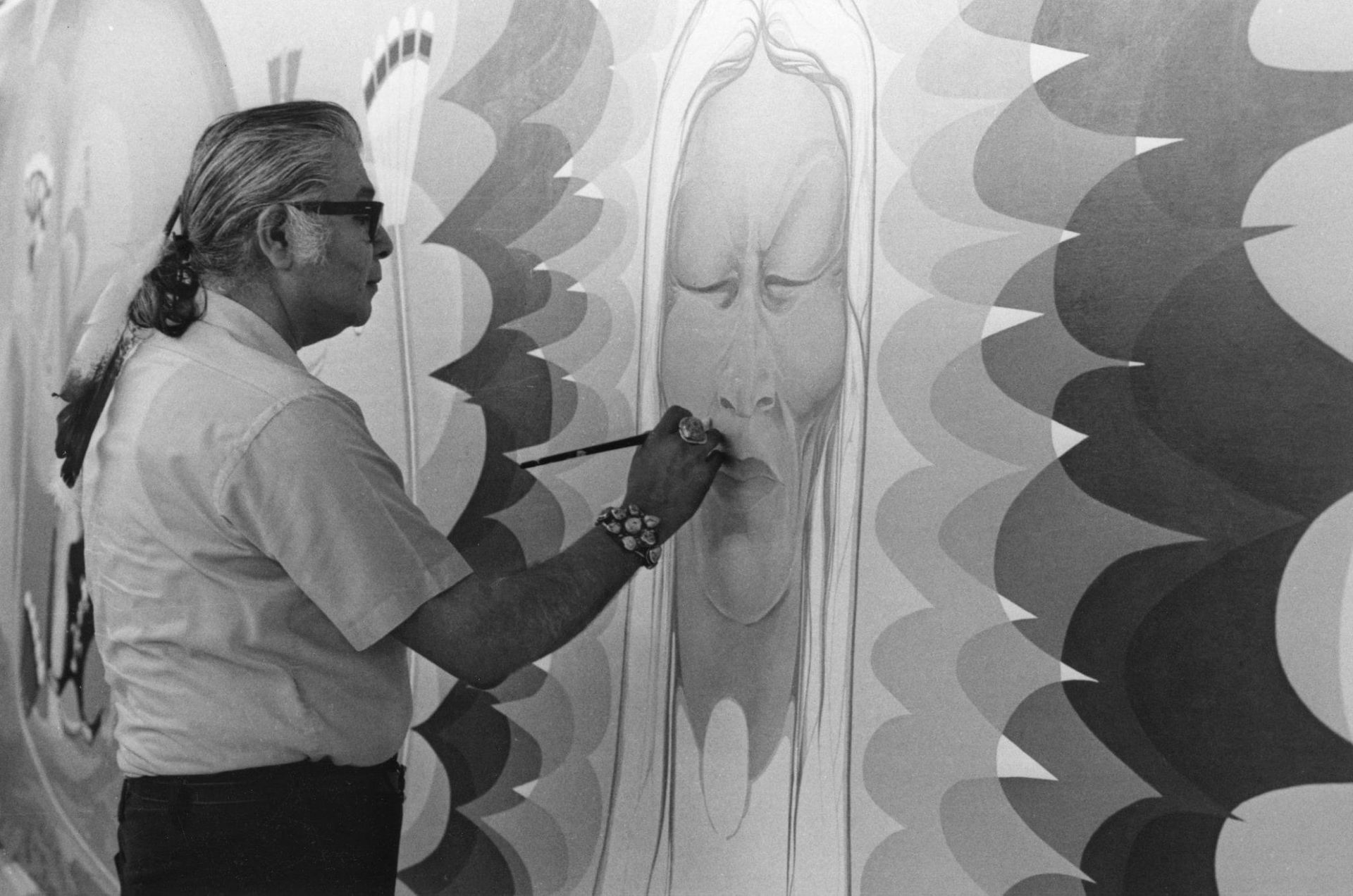Celebrating Keeper
of the Plains

“The late Blackbear Bosin, the artist who created the Keeper of the Plains, works on a painting that can be seen today at the Mid-America All-Indian Museum (file photo courtesy Mid-America All-Indian Museum).”
Photo courtesy Mid-America All-Indian Museum

Photo courtesy Taylor Hunt

Photo courtesy Taylor Hunt
Party for the People
May 18, 2024
Mid-America All-Indian Museum
The 50th anniversary for the Keeper of the Plains will be an all-day celebration. There will be a park run and a rededication ceremony in the morning and a powwow and festival in the afternoon, including outdoor games and activities, food trucks, Native American art exhibits, and ending with fireworks. This is a free, family-friendly event you won’t want to miss!
For complete schedule, go to visitwichita.com and search “Party for the People.”
Conceived to symbolize and promote prayerful unity among the indigenous tribes in the area, the Keeper of the Plains statue continues to hold out a welcoming olive branch to all who set eyes on it today.
First appearing on the grounds of Mid-America All-Indian Center (now Mid-America All-Indian Museum), the original statue design conceived by artist, muralist and designer Francis Blackbear Bosin evolved from some six 10-to-12 foot mobile works of art into the five-ton, 44-foot-tall steel sculpture that has become the most recognizable landmark in Wichita, standing stately at the intersection of the Big and Little Arkansas Rivers.
In celebration of its 50th year, the community will host a birthday party dedication, Party for the People, on May 18. Hosted by the Bosin Society, City of Wichita, Sedgwick County, and other sponsors, the free all-day event will feature a powwow, a rededication ceremony, Native performances, Native youth and adult art exhibits, free museum admission, food trucks, outdoor games and activities, and a fireworks show.
“We are excited to celebrate the 50th anniversary of the Keeper of the Plains, as we honor the rich cultural heritage and history of Wichita and its Indigenous roots,” said Jemelle Holopirek, director of public relations for Visit Wichita. “The Keeper stands as a symbol of unity and reverence for our community and the Native American traditions that shaped our city.”
Virginia Susan “Sue” Seal is a retired ethnologist and Wichita State graduate who worked alongside her uncle Blackbear Bosin in his souvenir shops in Wichita. A native of Redstone, Oklahoma, the now-retired 76-year-old was among the Kiowa and Comanche tribes who traveled in search of gainful employment during the early 1950s with their families to Planeview, a community in Wichita that came into being during World War II as temporary housing for more than 20,000 defense workers. Her mother, Betty Nixon, served on the board responsible for bringing the Indian Center into existence.
“At that point, it was all about providing for their families,” Seal said. “My uncle was an artist in his home life who came for work and worked at Boeing for a while doing graphic design. Eventually, his desire to create art led him to leave his job and strike out on the road to sell his paintings, doing the majority of his transactions with souvenir shops.”
As the fledgling community of Planeview grew, most of the families living there purchased modest homes and settled in the Quonset hut structures located there. Initially, many of them shared homes, Seal said.
“There was a dwelling on each end of the house,” she said. “Sometimes two or three families lived in one half, two or three in the other half.
The bonds that existed between the various tribes flourished, she said. Apache, Kiowa, Comanche, Wichita, and other natives lived together in harmony, despite the cultural differences between them.
But while the neighborhood climate seemed at peace, something was indeed missing from the picture. The spirit to gather and celebrate their cultures was strong among residents, but there was simply no designated place in town to do so. A few area churches would lend out their basements for such meetings, but those spaces were cramped and unaccommodating. That’s when the need to build an Indian center for gatherings became imminent.
“Natives in Wichita recognized we didn’t have a place to dance or get together to celebrate,” Seal said. “They had nothing for Native Americans. That’s when we started holding meetings at my parent’s home to promote an Indian center.”
Tasked as secretary, Seal said organizers of the gatherings chipped in to provide her with a tape recorder to track the minutes of each meeting. Eventually, their persistence led them to persuade Wichita city officials to build the native center.
“It took years for this dream to come true,” she said. “We needed a mutual place for everyone to dance and share their culture. Not all tribes are exactly alike.”
It was in that spirit of unity that the first Keeper of the Plains statues were born.
“The first statue was at the Indian Center set up by itself,” Seal said. “It was small and was only up for about 1 ½ years. At one time there were three smaller ones around the Indian Center.”
The statue as it stands today was designed by Bosin in 1968 at the behest of Kansas Gas and Electric Company. Part of a beautification project, it was earmarked to be placed at the confluence of the Big and Little Arkansas Rivers on land owned by KG&E. Funding shortages delayed the project’s completion until May 18, 1974. Prior to its completion, the sculpture was adopted as the bicentennial symbol of the Wichita community, leading to financial support from the Wichita City Commission, State Bicentennial Commission, and Quivira Council of Boys Scouts of America.
As part of a subsequent beautification project in 2006, the City of Wichita elevated the Keeper onto a 30-foot rock and added bridges and a plaza area. Facing east toward the rising sun, the structure stands on a large rock with a wooden door image bearing a turtle cut into it.
From its conception, Bosin’s iconic statue was intended to promote a spirit of unity among area tribes, Seal said. The subject’s posture with hands held high to the heavens symbolizes a call for spiritual union within the community.
“In the drawing itself, he knew that gesture was going to have meaning,” she said. “That’s why his (the sculpture’s) hands are up. He is praying for peace and goodwill for the people of Wichita. When you pull that many people together, for us, that’s a big thing, because we all have different beliefs.
“The statue is there for all Native people and those who care about them. As my uncle would say to me, ‘We were here first. This is our home.’ ”
